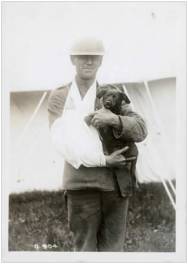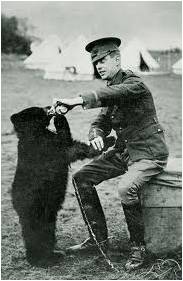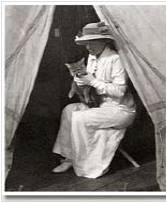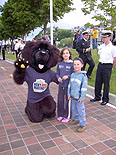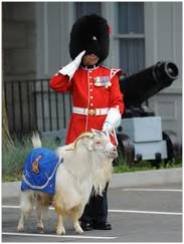Military Mascots & Service Animals
| Animals Serving at Home to Combat Operational Injuries
Not only have animals worked side-by-side with the military for centuries on the front-line they have also played a pivotal role as mascots, as well as aids such as service dogs. Dogs and horses, for example, help manage stress and the fallout of operational stress and related injuries. The Canadian Foundation for Animal Assisted Support Services (CFAS) recognizes these significant relationships and how the human-animal bond improves quality of life. One of the first guide dogs was trained for a soldier in Germany who had lost his eyesight as a result of serving. With this in mind CFAS invited Major-General Lew MacKenzie (Rtd) to become a patron of the foundation naming a national military fund in his honour. Read more… |
|
Man’s Best FriendA wounded Canadian soldier holds his puppy. Animals of all kinds lived in the trenches alongside soldiers. George Metcalf Archival Collection CWM 19920044-805 Soldiers’ Pets Many soldiers had pets in and near the front line trenches. Small dogs and cats were most common, and they helped soldiers normalize the harsh world of combat. Enemy pets were sometimes adopted after a battle, renamed, and became part of the soldiers’ community. Winnie the Most Famous Mascot The most famous Canadian mascot was a black bear cub named Winnipeg which traveled overseas from Canada. The unit decided to place Winnie in the London Zoo, rather than subject him to the rigours of the front. He delighted thousands of visitors and later became the inspiration for A.A. Milne’s Winnie-the-Pooh. Source: Canadian War Museum Military Mascots and the Canadian Black Bear Everyone has, of course, heard of Winnie the Pooh, seen the books, the movies, and hear rumors about the origins of the little bear. Winnie the Pooh was originally a young female black bear named Winnipeg that was adopted by a member of the Second Canadian Infantry Brigade, and later became the Brigade’s mascot. She travelled with them to Britain, and eventually came to live at the London Zoo, where a young boy named Christopher Robin adored her and inspired the stories that are so well known today. Read more…
Lieutenant-Colonel John McCrae and his dog Bonneau / Le lieutenant-colonel John McCrae et son chien Bonneau BiblioArchives / LibraryArchives Source
|
Young Lady and Lestock, 1915 On 30 May 1915 a well-wisher from Lestock, Saskatchewan gave the 49th Battalion a coyote pup. The train carrying the 49ers was making a stop at the Saskatchewan town. The Regiment, which was en route to England, adopted the pup as the unit’s mascot and named it “Lestock.” Lestock was turned over to a London zoo before the 49th went into combat. To this day, Lestock’s face appears in the centre of the unit badge. Source: City of Edmonton Archives, Loyal Edmonton Regiment Collection. Juno the bear is the now the Canadian Army’s official mascot. His name will help Canadians remember D-Day, June 6, 1944, when 15,000 Canadian troops stormed ashore on Juno Beach on the Normandy coast of France. More than 1,000 Canadians were injured and 340 gave their lives. Source: Canadian Army Website Other Military Mascots and Links Royal Canadian Navy Mascot Sonar Military units identified themselves with adopted animal mascots, including goats, dogs, and birds. The animals lived in the field alongside the soldiers. Tales of Animals in War – Loveable Mascots
Royal 22e Régiment (R22eR)
Penguins, ferrets and kangaroos: The best military mascots from around the world National militaries take great pride in representing their countries in the troubled corners of the world that they call home while on active duty. And just as our national militaries are meant to represent us around the world, so a diverse group of animals have been representing armies and regiments throughout history as military mascots. Read more… Library and Archives Canada Blog
The Mascot (3rd Canadian Infantry Battalion) Source |
|
At all times, animals were alongside soldiers on the front as companions in misfortune. From the very beginning, military mascots have served to represent the group who adopted them. Even members of the Canadian Expeditionary Force had mascots during the First World War, as shown in the following image. Read more… |
|

